Rank: Member
Groups: Member
Joined: 8/17/2010(UTC)
Posts: 368
Location: australia
Thanks: 8 times
Was thanked: 3 time(s) in 3 post(s)
|
Because I have so many issues with the quality of my AC I am going to run the system via a 12V battery bank & an Inverter.
Then I started thinking I could run a some of the components directly from the batteries and keep the inverter for the ones I cannot run from the 12V batteries.
I figure I could run the Squeezebox Touch, the Arduino setup, the BIII & peripheral modules from the batteries easy enough but the IVY has got me stumped.
I have two question:
1) Why do you use a Bipolar PSU for the IVY, why use a Bipolar PSU period?
2) Is there a way I could easily get a bipolar supply from the batteries.?
|
|
|
|
|
|
Rank: Member
Groups: Member
Joined: 8/17/2010(UTC)
Posts: 368
Location: australia
Thanks: 8 times
Was thanked: 3 time(s) in 3 post(s)
|
Hows this look? 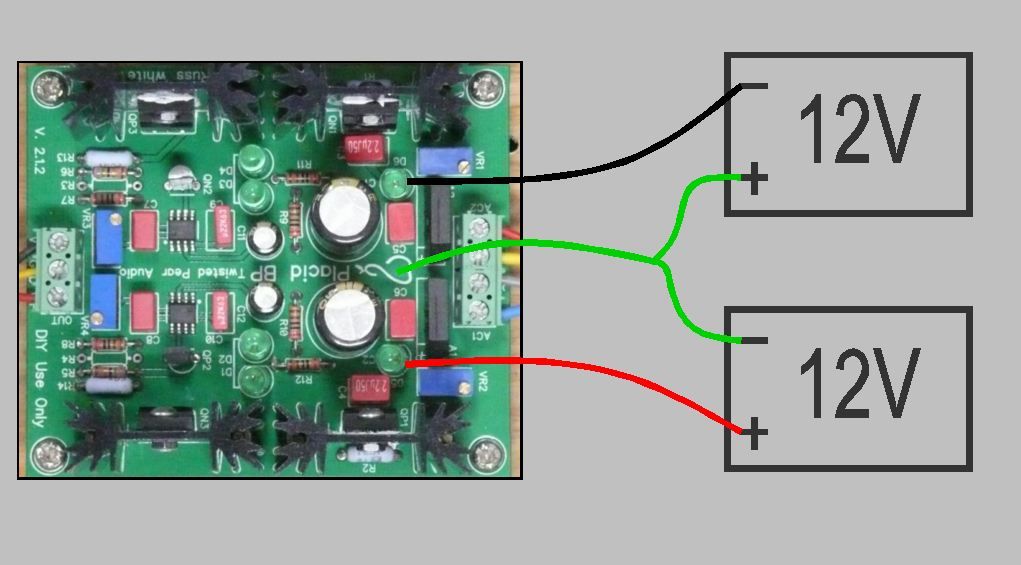
|
|
|
|
|
|
Rank: Member
Groups: Member
Joined: 8/17/2010(UTC)
Posts: 368
Location: australia
Thanks: 8 times
Was thanked: 3 time(s) in 3 post(s)
|
Hmm, not sure about this? 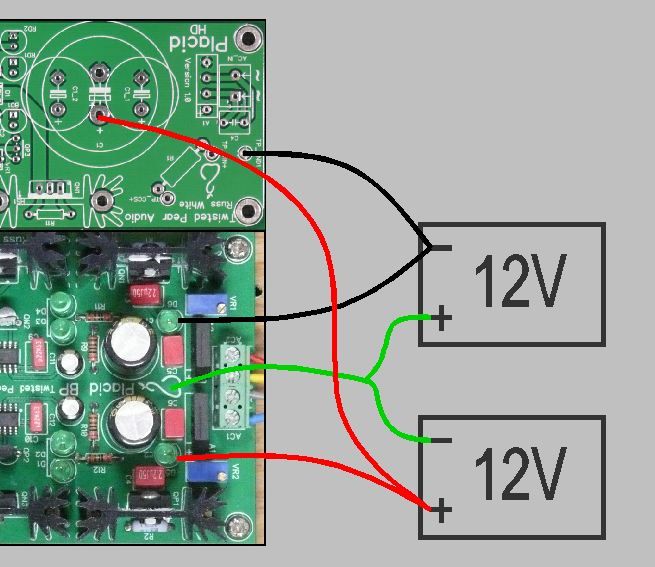
|
|
|
|
|
|
Rank: Member
Groups: Member
Joined: 8/17/2010(UTC)
Posts: 368
Location: australia
Thanks: 8 times
Was thanked: 3 time(s) in 3 post(s)
|
Wrong thread :) Edited by user Friday, June 7, 2013 10:54:01 AM(UTC)
| Reason: Not specified
|
|
|
|
|
|
Rank: Administration
Groups: Administration, Customer
Joined: 10/24/2006(UTC)
Posts: 3,979
Location: Nashville, TN
Thanks: 25 times
Was thanked: 89 time(s) in 83 post(s)
|
Wire it just like it were a transformer, the rectifier will pass DC appropriately.
|
|
|
|
|
|
Rank: Member
Groups: Member
Joined: 8/17/2010(UTC)
Posts: 368
Location: australia
Thanks: 8 times
Was thanked: 3 time(s) in 3 post(s)
|
Like this ? 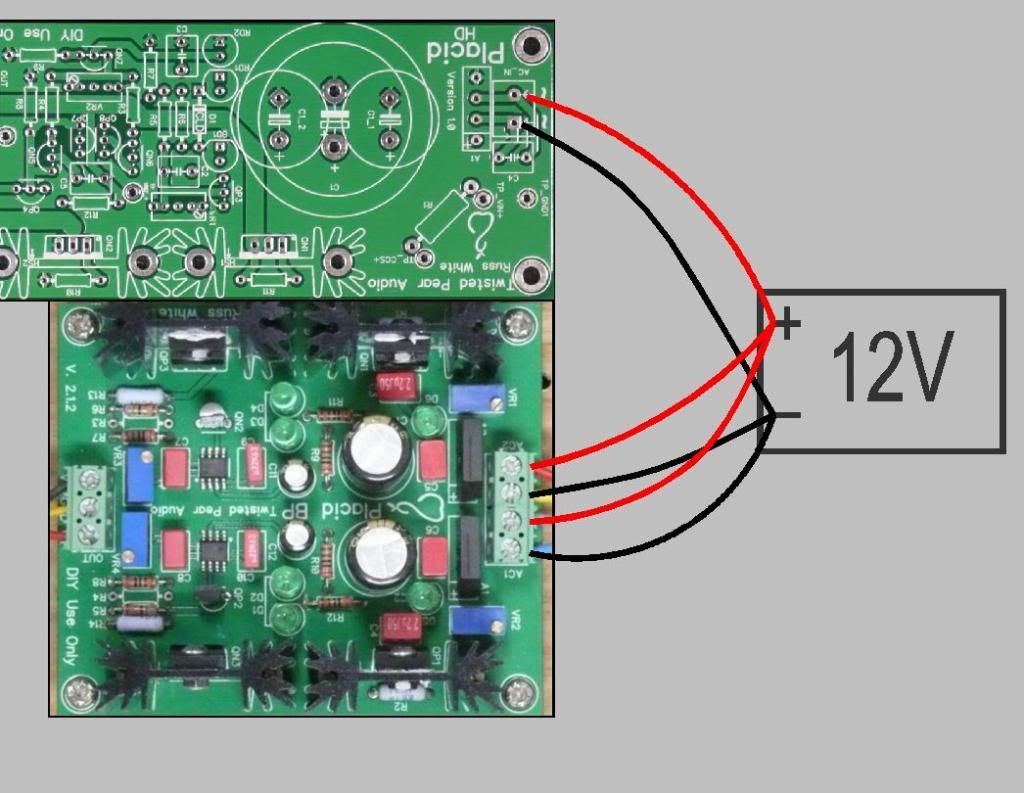
|
|
|
|
|
|
Rank: Administration
Groups: Administration, Customer
Joined: 10/24/2006(UTC)
Posts: 3,979
Location: Nashville, TN
Thanks: 25 times
Was thanked: 89 time(s) in 83 post(s)
|
Not exactly, but close.
You will want one battery per rail.
Even better would be to use two in series(24V) for each bipolar rail.
The regulator needs some headroom.
|
|
|
|
|
|
Rank: Member
Groups: Member
Joined: 8/17/2010(UTC)
Posts: 368
Location: australia
Thanks: 8 times
Was thanked: 3 time(s) in 3 post(s)
|
Hmm, 24volts, that adds extra costs which I was hoping to avoid, ie, 24volt charger. I have an endless supply of (free)12v deep cycle batteries so that helps a lot cost wise, they are all 2 years old but in excellent condition.
The batteries fully charged (which they will be most of the time) give 13.2V If I connect on the other side of the bridge I forgo the 1.2v voltage drop from the diodes so I can't be far off the voltage that the transformer is giving.
If it gets too difficult I may just stick with the full wave inverter & run the easy things from the batteries.
Thanks for the help.
|
|
|
|
|
|
Rank: Member
Groups: Member
Joined: 5/23/2010(UTC)
Posts: 708
Location: Netherlands
Thanks: 2 times
Was thanked: 48 time(s) in 45 post(s)
|
You still can use all of the stuff available. Just hook 2 batteries up in series to get to 24V. Plus 24V would only be required for the BP supplies.
|
|
|
|
|
|
Rank: Member
Groups: Member
Joined: 8/17/2010(UTC)
Posts: 368
Location: australia
Thanks: 8 times
Was thanked: 3 time(s) in 3 post(s)
|
Originally Posted by: LeonvB  You still can use all of the stuff available. Just hook 2 batteries up in series to get to 24V. Plus 24V would only be required for the BP supplies. As this would be permanently hooked up I would need a 24volt charger to go with my 12volt charger. I would end up with 2 x 24volt banks for the BP then a 12volt for the rest & the inverter that would be needed for the amps & crossover. My Linkwitz ASP crossover runs from a 12V BP SMPS so for that to be battery I would probably need 2x12v batteries setup in a BP configuration like my first image. That be another bank of batteries. Of course the Squeezebox Touch needs 5v. Things quickly get complicated :) I think I'll start with the inverter & a single 12v & 5v supply from the batteries & add to that as I go. Edited by user Monday, June 10, 2013 3:41:32 AM(UTC)
| Reason: Not specified
|
|
|
|
|
|
Rank: Administration
Groups: Administration, Customer
Joined: 10/24/2006(UTC)
Posts: 2,869
Location: Massachusetts, USA
Thanks: 2 times
Was thanked: 141 time(s) in 134 post(s)
|
I am doubtful that an inverter will give you cleaner AC than you get from the utility.
|
|
|
|
|
|
Rank: Member
Groups: Member
Joined: 5/23/2010(UTC)
Posts: 708
Location: Netherlands
Thanks: 2 times
Was thanked: 48 time(s) in 45 post(s)
|
Originally Posted by: DQ828  As this would be permanently hooked up I would need a 24volt charger to go with my 12volt charger. No you don't. Use 3 wires for access to each pole. You get 24V on the ends, but still have 12V by using the centre. Easy and cheap.
|
|
|
|
|
|
Rank: Member
Groups: Member
Joined: 8/17/2010(UTC)
Posts: 368
Location: australia
Thanks: 8 times
Was thanked: 3 time(s) in 3 post(s)
|
Originally Posted by: Brian Donegan  I am doubtful that an inverter will give you cleaner AC than you get from the utility. In 54 years I have never encountered the AC issues like I have in the existing house. The utility are not prepared to do anything about it & dont seem to know why the problem is so bad a my house. The utility sends signals down the lines to turn infrastructure on and off, normally you dont notice the signals but in my house they make everything with a ballast & or transformer buzz, even my Squeezebox Touch buzzes, the bigger the tranny the bigger the buzz. The signal are mainly sent at night and happen on a regular basis from about 5:00pm till who knows when, you can set your clock by them. The 650VA tranny's in my amps really sing. Needless to say I sent the night turning the system on & off. It's driving me crazy :)
|
|
|
|
|
|
Rank: Member
Groups: Member
Joined: 8/17/2010(UTC)
Posts: 368
Location: australia
Thanks: 8 times
Was thanked: 3 time(s) in 3 post(s)
|
Originally Posted by: LeonvB  Originally Posted by: DQ828  As this would be permanently hooked up I would need a 24volt charger to go with my 12volt charger. No you don't. Use 3 wires for access to each pole. You get 24V on the ends, but still have 12V by using the centre. Easy and cheap. I'm not sure exactly what you mean but I'll ponder on it. So are you saying I dont need a 24v charger & I can pull 12v & 24v from the batteries at the same time wired like my first image? If I dont need a 24v charger how would I wire the charger to the 2 x 12v batteries that will be wired in series to get the 24vs Edited by user Tuesday, June 11, 2013 12:08:28 AM(UTC)
| Reason: Not specified
|
|
|
|
|
|
Rank: Member
Groups: Member
Joined: 5/23/2010(UTC)
Posts: 708
Location: Netherlands
Thanks: 2 times
Was thanked: 48 time(s) in 45 post(s)
|
Yes, you don't need a 24V charger. Do use multiple packs however. I'll see if you can create a picture to make it more clear. The procedure is simple: - Connect a wire to the - of the first battery. Lets call it point A. - Connect the + of the first battery to the - of the second battery, PLUS create a T by running a wire from the bridge to point B. - Connect a wire to the + of the second battery. Call this C. It's obvious that from A to C you'll have 24V. But A to B and B to C are still 12V. Connect the 12V charger there and charge the batteries individually. It will take twice the amount of time of course, but you'll get there. LeonvB attached the following image(s):  pack.jpg (8kb) downloaded 7 time(s).You cannot view/download attachments. Try to login or register.
|
|
|
|
|
|
Rank: Member
Groups: Member
Joined: 8/17/2010(UTC)
Posts: 368
Location: australia
Thanks: 8 times
Was thanked: 3 time(s) in 3 post(s)
|
Originally Posted by: LeonvB  Yes, you don't need a 24V charger. Do use multiple packs however.
I'll see if you can create a picture to make it more clear. The procedure is simple:
- Connect a wire to the - of the first battery. Lets call it point A.
- Connect the + of the first battery to the - of the second battery, PLUS create a T by running a wire from the bridge to point B.
- Connect a wire to the + of the second battery. Call this C.
It's obvious that from A to C you'll have 24V. But A to B and B to C are still 12V. Connect the 12V charger there and charge the batteries individually. It will take twice the amount of time of course, but you'll get there. Thanks I'll do some testing & draw some diagrams, I know you might find this hard to believe (or maybe not :) ) but I'm still not completely clear on this subject but I figure if I connect some batteries together & have a play with the DMM it will help. thanks again.
|
|
|
|
|
|
Rank: Administration
Groups: Administration, Customer
Joined: 10/24/2006(UTC)
Posts: 2,869
Location: Massachusetts, USA
Thanks: 2 times
Was thanked: 141 time(s) in 134 post(s)
|
Originally Posted by: DQ828  Originally Posted by: Brian Donegan  I am doubtful that an inverter will give you cleaner AC than you get from the utility. In 54 years I have never encountered the AC issues like I have in the existing house. The utility are not prepared to do anything about it & dont seem to know why the problem is so bad a my house. The utility sends signals down the lines to turn infrastructure on and off, normally you dont notice the signals but in my house they make everything with a ballast & or transformer buzz, even my Squeezebox Touch buzzes, the bigger the tranny the bigger the buzz. The signal are mainly sent at night and happen on a regular basis from about 5:00pm till who knows when, you can set your clock by them. The 650VA tranny's in my amps really sing. Needless to say I sent the night turning the system on & off. It's driving me crazy :) Sounds like a bad neutral. You'll probably have to wait for the pole transformer to die before it gets fixed.
|
|
|
|
|
|
Rank: Member
Groups: Member
Joined: 8/17/2010(UTC)
Posts: 368
Location: australia
Thanks: 8 times
Was thanked: 3 time(s) in 3 post(s)
|
I finally got time to sort out the battery power supply, at this stage it's going through the Inverter. When I get a few other things out of the way I'll look at going battery direct to components. Because the noise in my electricity supply is so tenacious I have rigged up 2 relays to disconnect the battery charger completely from the power supply, (disconnect active, neutral & earth) during normal listening hours. Generally the noise only starts at about 5 in the afternoon & is spasmodic throughout the night. The system is, timer to switch relays, relays to disconnect battery charger from power, battery charger, batteries & finally the inverter. I get the batteries for free, they are all about 2 years old & done light duties, if one die's another one's not far away. Each battery is rated at 12AH therefore there is 48AH in each box. I have made the boxes stackable. The brass threaded rod on the top box runs through the box so it mates with the brass threaded rod on the bottom box and theoretically they don't need to be connected in any other way as the current runs through the threaded rod. The standard method of connecting multiple batteries in parallel is to daisy chain them, but in my research on the subject that method appears to have serious short comings. Apparently the first battery in the line gets the life sucked out of it & the AH supplied by the following batteries drops off rapidly, ie by the time the first battery is dead the last battery has only given half it's charge. This is only applicable once you have 3 or more batteries. The go is to try & connect them all to one point & keep the leads the same length, because miniscule (so I read) differences in resistance make big differences in performance.  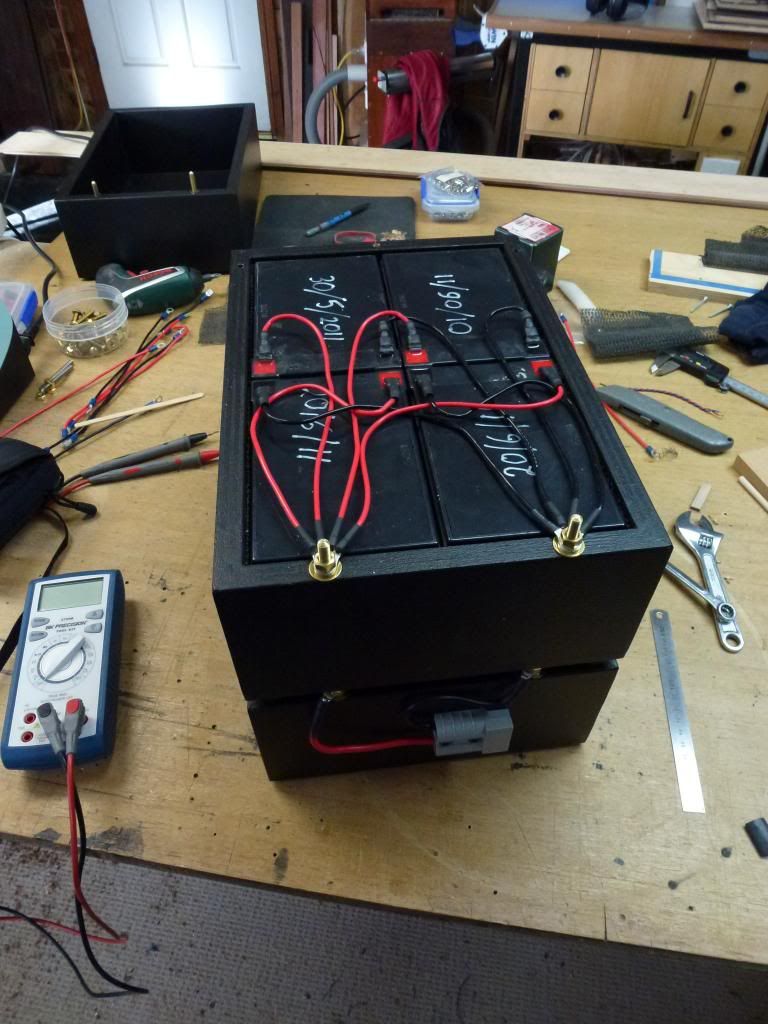 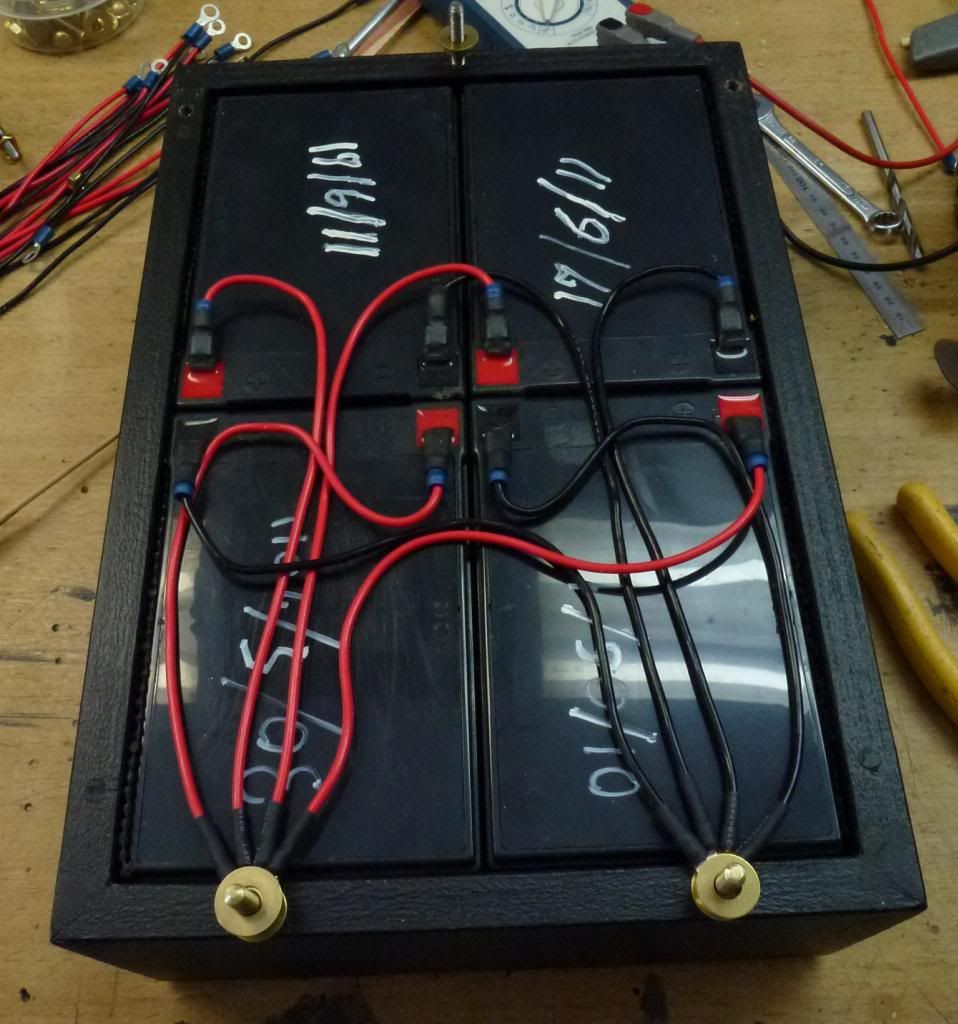
|
|
|
|
|
|
Forum Jump
You cannot post new topics in this forum.
You cannot reply to topics in this forum.
You cannot delete your posts in this forum.
You cannot edit your posts in this forum.
You cannot create polls in this forum.
You cannot vote in polls in this forum.